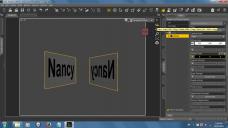(beginner question) default surface opacity on primitive objects?
 Roman_K2
Posts: 1,252
Roman_K2
Posts: 1,252
Might be I'm missing something in DS 4.8 here... I created a rectangle floating vertically in space. I want to put an image (JPEG or BMP?) on it, just some text like Tom, Dick and Harry so that it looks like a name badge say.
This seems easy enough to do... after checking that opacity was cranked all the way up pretty much, I rotated the object 45 degrees and got a surprise: the "filled" primitive plane was 100 percent transparent - the name "label" could be read in reverse! What is going on? Any and all pointers appreciated.


nancy.jpg
1024 x 576 - 139K


Comments
This is actually the correct behavior for single 'thickness' items. It's not transparent, it's just reversed, because the normals are pointing the other way...
I thought it might be something like that. So the best plan moving forward is to increase the scale a bit, or go back to square one and create a thicker object from scratch, in Hexagon?
Btw. just about all of my content has "disappeared", in DS 4.8 so I guess I must have accidentally pressed some sort of wrong key sequence.
Content Library or Smart Content?
And yes, something that has actual thickness...and if you want make it two material zones, that way the bac can be independently textured from the front.
Er, "Content Library" has sort of "vanished" - eg. there are not items. I now have an empty looking pane that moments ago had a lot of stuff in it.
Aha, "two material zones"... I hadn't gotten that far yet, in Hexagon and DS. Thanks.
Look very, very closely at the slightly darker bar separating the suddenly blank part and the rest of the Content Library pane. There's a tiny button with a tinier arrow in the middle of that bar, used for collapsing and expanding parts of a pane. It's very useful for customising the layout exactly the way you want it, but it's way too easy to hit by accident if your mouse click is half a pixel off-course, and it isn't always very obvious what's happened. Most of us (even experienced long-time users) get bitten by this one every now and then.
I was clicking around and **I think** I figured it out, yeah... thanks for the detailed explanation.
Probably the easiest way to do is to use a Cube primitive and set the ZScale to something like 1% so it's very thin.